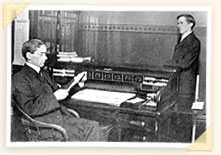 If I had been psychiatrist-in-chief
from 1923 to 1947… If I had been psychiatrist-in-chief
from 1923 to 1947…
I would definitely be a man and would start off as the medical
superintendent of the Protestant Hospital for the Insane at
Verdun, which within 2 years would change its name to the Verdun
Protestant Hospital. I would be starting my mandate in charge
of 800, mostly involuntary hospitalized patients, who were
segregated by sex. I would be admitting more patients than
ever, but also boasting a record discharge rate of 67%.
I would
be proud of new advances that allowed for specific treatments
of at least some of our patients—malaria as a cure for
general paresis, manganese chloride injections for dementia
praecox and sulphonal, paraldehyde, bromides, and injections
of hyoscine and apomorphine to manage excited states. Our hospital
would be experimenting with the induction of twilight sleep
to control agitated patients, as well as trying out hydrotherapy
with cold packs and offering state-of-the-art occupational
therapy.
By 1934, I would be ensuring that all our patients
benefited from a full medical examination and a chest X-ray
on admission. I would be credited with the hiring, in 1937,
of a young, enthusiastic and creative psychiatrist named Heinz
Lehmann, who would one day revolutionize the treatment of the
mentally ill on our continent. I would also make my mark by
hiring, in 1936, Mary Palmer, MD, the first woman physician
to work at the hospital. Although she only lasted one year,
the ice would be broken and others would follow.
Towards the
end of my mandate, as patient numbers peaked at 1,700, I would
facilitate the introduction of insulin coma treatment for schizophrenia—as
it was now being called, and electroconvulsive therapy for
severe depression. I would also be credited with the development
of somnol, a new sleeping pill that had the advantage of being
non-addictive, because it produced very unpleasant side effects
if taken in large doses and was suicide-proof, because it would
cause vomiting if taken in overdose.
I would be on hand to
hire the first psychologist in 1945 and could now pride myself
with working in a multidisciplinary institution with staff
from four professional groups: medicine, nursing, occupational
therapy and psychology.
Finally, the lobbying would pay off
and in 1946 the Verdun Protestant Hospital would become a McGill-affiliated
teaching hospital. At last we would welcome residents and interns
from the McGill Faculty of Medicine and get some much-needed
help caring for the ever-growing inpatient population.
«« Back
|